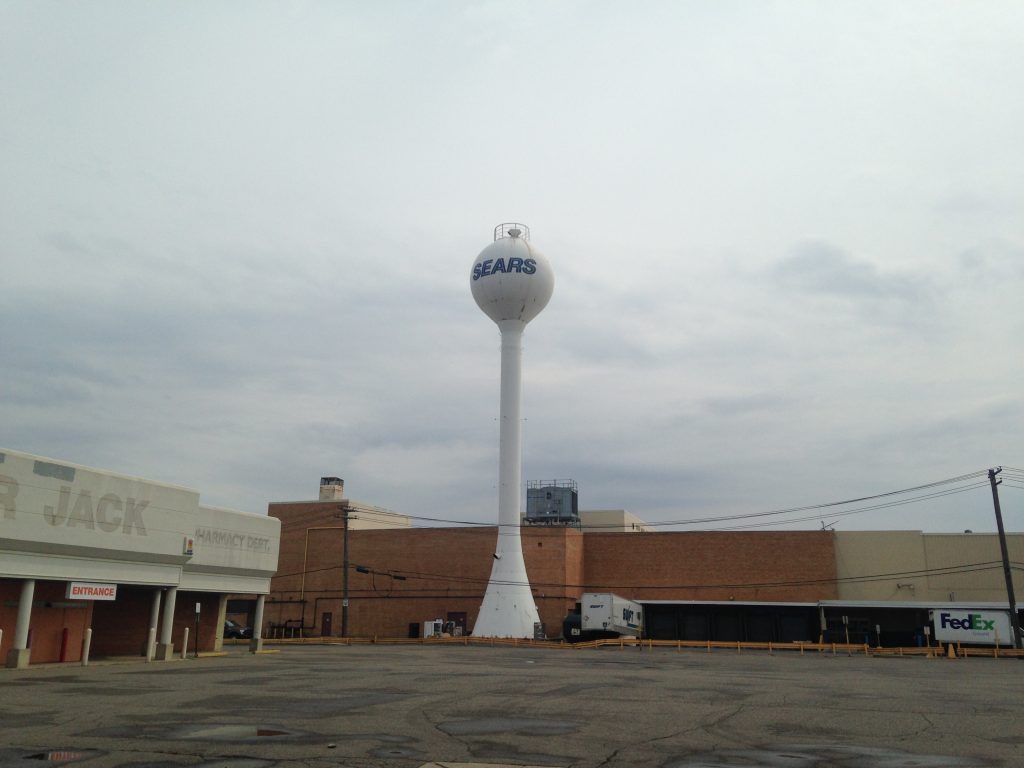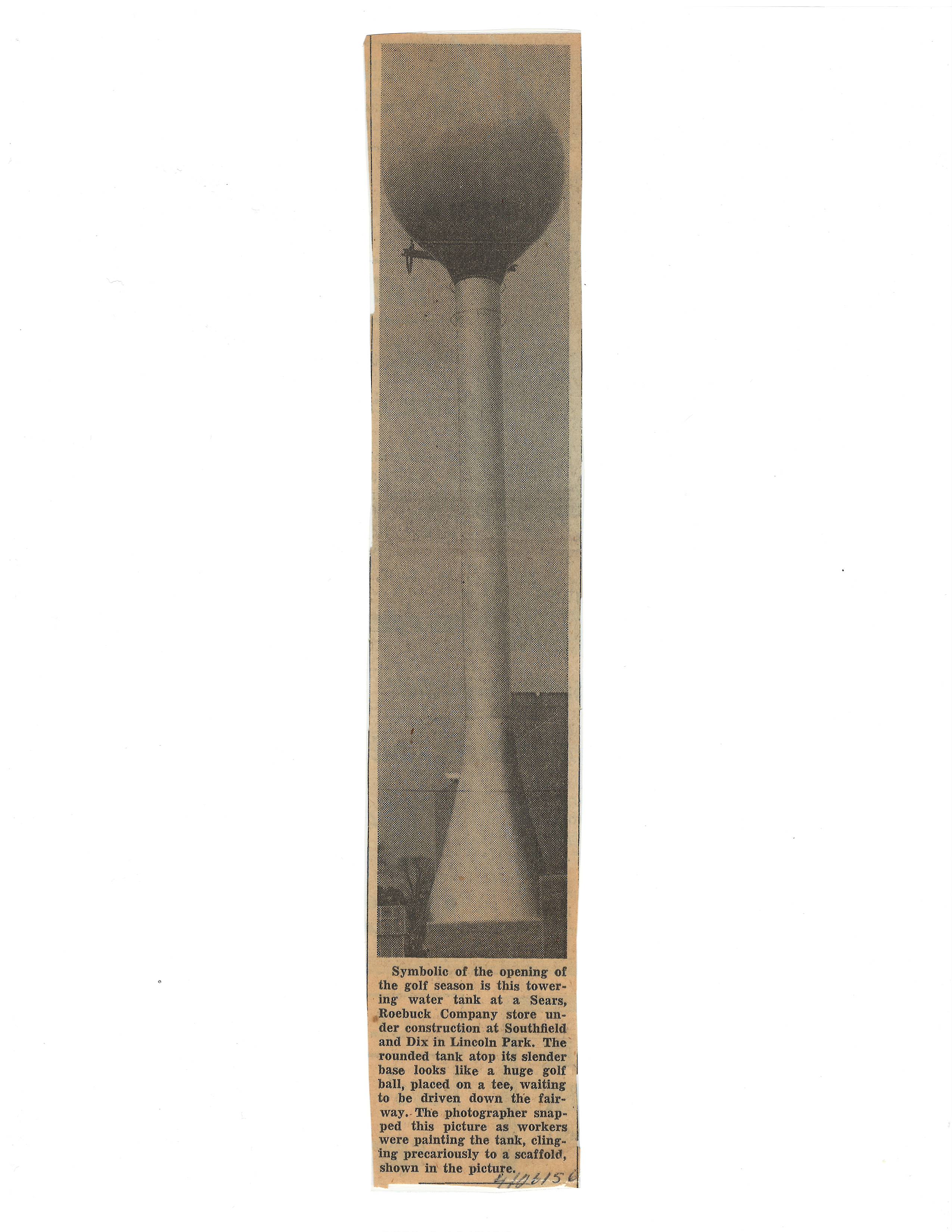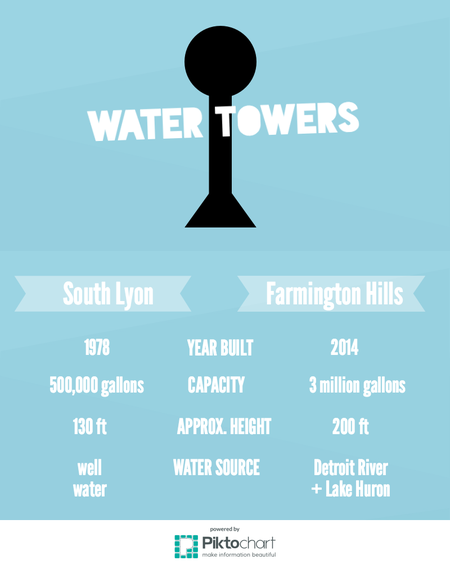CuriosiD: What Are Water Towers Used for Today?
Laura Herberg May 9, 2016Listener Carl Prunkard wants to know what’s up with water towers.

For this edition of CuriosiD, listener Carl Prunkard of Taylor, Michigan asked…
I used to be from Lincoln Park and our hometown had a water tower. Why did we have it? Why did some cities have these huge water towers, and what did they use them for? | Carl Prunkard
Click on the audio player above or use this link to hear the audio.
The Short Answer
Whether servicing a town, a factory or a shopping center, these elevated storage towers use gravity and the weight of water to push the resource through pipes, in an energy-efficient, and cost-effective manner. A filled tower can also supply water when electricity is out. In Metro Detroit, a tower can help a community save money and reduce strain on the water system by allowing towns to draw water in the middle of the night when demand is low.
Water Tower Map
Click on the pins to view more information. Click on the + to add a tower or update a tower’s location, information or photo using this online form.
Why Would a Retailer Need a Tower?

Carl Prunkard remembers an army green tower where the Michigan Liquor Control Commission used to have a distribution warehouse at 2251 Dix Hwy in Lincoln Park. Any tower at that site has long been torn down. But just a few blocks up the street, there is an iconic water tower that looks like a q-tip with a Sears logo on it. The landmark was built along with a Sears department store in 1956. But why would a retailer need a water tower?
Harold Stuhlberg was one of the store’s owners in the 1970’s. “When the store was built, they didn’t have enough water pressure… for fire suppression for sprinkler systems,” Stuhlberg says.
At the time, Lincoln Park’s water pressure wasn’t powerful enough to support the water needs of a store of this size – so Sears built its own tower!
Today, the city’s system is more powerful, but the department store still uses the tower. It creates pressure, not just for its sprinklers, but for the toilets and sinks – all of the store’s water needs. And this Sears is not alone. Ever noticed the orange water tower at Twelve Oaks Mall in Novi? It serves the same purpose.
South Lyon’s ‘Bath tub in the Sky’
Bob Martin is the Superintendent of the Water Department in South Lyon. We talked at the base of his city’s tower. It looks like a giant golf ball on a tee.
“I’m scared it’s gonna fall on us and crush us,” I tell him after we step out of his truck.
“It’s an incredible view when you stand under one,” Bob acknowledges.
There’s a tiny, arched doorway at the bottom of the tower, secured with a padlock. Martin and I step inside. It’s like being in a hollowed out, upside-down, metal cone. Surprisingly there’s no water in sight – just one vertical steel pipe, small enough for me to hug. It leads from the tank above us to the ground.
“Unbeknownst to most people, when you’re standing on the ground, if you dug down, you would find a gigantic underground lake called an aquifer,” Martin explains.
South Lyon uses wells to get its water which is then pumped through mains. These are large pipes that carry water along the streets.
“When it gets down to the end of the block where the water tower is – that pipe leads right into the base of the water tower,” Martin said. “And as water enters the water tower it is pumped up to the very large ball at the very top… and it fills, not unlike how we fill bath tubs at home.”
“So, it’s kind of like a bath tub in the sky?” I ask.
“Exactly, it’s like a bathtub in the sky!” agrees Martin. “Once it gets up there you have to understand that the weight of this tower is massive – because it holds so much water, and the weight of water’s heavy.
“It’s putting pressure as it pushes the water down through the pipe and out through the existing pipes to the neighborhoods, people’s homes, churches, schools and businesses.”
If South Lyon didn’t have this water tower, it would have to install several electric-powered pumps to push water throughout the system. Right now, the city just has to pump the water into the tower, which uses less energy.
To go back to the bath tub analogy: “When you open the drain on your bath tub, what does it do? It drains down that pipe. That’s exactly what we’re doing with water towers. We’re filling it, and then it drains down the pipe and to the neighborhoods,” says Martin.
Not Just a Thing of the Past
Farmington Hills just finished construction on its tower in 2014. Karen Mondora is the Assistant to the Public Services Director for the city. The tower stands in front of us with the words, “Live Farmington Hills, Love Farmington Hills,” written festively in the city’s colors, green and black.
“Everybody always asks, ‘When are they gonna come and put the top on the water tower?’ I can assure you that there is in fact a solid top on the tower. It’s just more of a flatter profile,” explains Mondora.
A steel bowl-shaped tank sits atop a concrete pedestal. This tower is massive. At the base, there is an entrance that looks like a garage door. We step inside and it’s like being in a cylinder-shaped warehouse. As we climb up a winding metal staircase to the second floor, I tell Mondora that it looks like it could be a rustic, loft apartment.
“Some communities, I don’t know of any in Michigan, actually finish out the interior and put their utility billing and some of their public works staff in some of the lower levels,” says Mondora.
On the second level, it feels like we’re inside a utilitarian cathedral. The nearest ceiling – the base of the tank – stands 150 feet above ground. Like South Lyon’s tower, there is no visible water in here, just a of couple pipes: One to fill and drain the tank and another for emergency overflow.
Farmington Hills buys treated water from the Great Lakes Water Authority, which is pumped from Lake Huron and the Detroit River. It costs more when drawn during peak usage hours, like in the mornings, when people get ready for the day.
“So, we were able to determine that building a 3 million gallon water tower would allow us to save about 4 million dollars a year in wholesale water charges,” says Mondora.
With the tower, Farmington Hills now stores up water in the middle of the night, when demand is low and less expensive. Plus, the city has water that it can pump to residents, even if the power goes out.

Singing a Water Tower’s Praises
One other perk of an elevated tower like this one in Farmington Hills? The extremely high ceiling makes for a great echo.
“I kind of want us to yell in here,” I tell Mondora. “What should we say? “
Without any hesitation she shouts, “I love public works!”
It’s funny, in the course of reporting on this story, Mondora and Martin both said the same thing to me about their jobs: that they work hard every day to get water into people’s homes, but no one seems to notice until there’s a problem.
I can’t help but think that the same goes for these towers. Even though they stand high in the sky, most of us don’t realize the important job they do every day.
